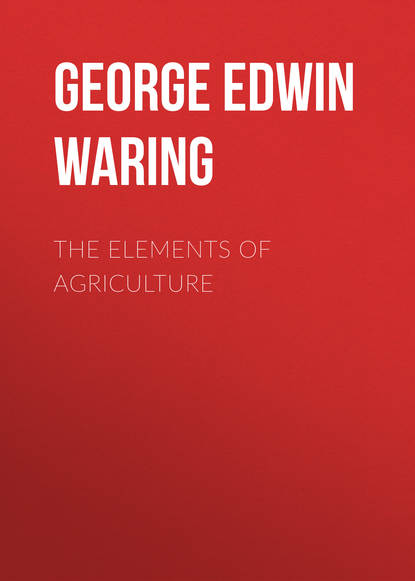По всем вопросам обращайтесь на: info@litportal.ru
(©) 2003-2024.
✖
The Elements of Agriculture
Настройки чтения
Размер шрифта
Высота строк
Поля
What is the condition of the alkalies in most of their combinations? Of the acids?
What is said of phosphate of lime?
The more minute ingredients of the soil—those which enter into the construction of plants—exist in conditions which are more or less favorable or injurious to vegetable growth. The principal condition necessary to fertility is capacity to be dissolved, it being (so far as we have been able to ascertain) a fixed rule, as was stated in the first section, that no mineral substance can enter into the roots of a plant except it be dissolved in water.
The alkalies potash, soda, lime, and magnesia, are in nearly all of their combinations in the soil sufficiently soluble for the purposes of growth.
The acids are, as will be recollected, sulphuric and phosphoric. These exist in the soil in combination with the alkalies, as sulphates and phosphates, which are more or less soluble under natural circumstances. Phosphoric acid in combination with lime as phosphate of lime is but slightly soluble; but, when it exists in the compound known as super-phosphate of lime, it is much more soluble, and consequently enters into the composition of plants with much greater facility. This matter will be more fully explained in the section on manures.
How may silica be rendered soluble?
What is the condition of chlorine in the soil?
Do peroxide and protoxide of iron affect plants in the same way?
How would you treat a soil containing protoxide of iron?
On what does the usefulness of all these matters in the soil depend?
The neutrals, silica, chlorine, oxide of iron, and oxide of manganese, deserve a careful examination. Silica exists in the soil usually in the form of sand, in which it is, as is well known, perfectly insoluble; and, before it can be used by plants, which often require it in large quantities, it must be made soluble, which is done by combining it with an alkali.
For instance, if the silica in the soil is insoluble, we must make an application of an alkali, such as potash, which will unite with the silica, and form the silicate of potash, which is in the exact condition to be dissolved and carried into the roots of plants.
Chlorine in the soil is probably always in an available condition.
Oxide of iron exists, as has been previously stated, usually in the form of the peroxide (or red oxide). Sometimes, however, it exists in the form of the protoxide (or black oxide), which is poisonous to plants, and renders the soil unfertile. By loosening the soil in such a manner as to admit air and water, this compound takes up more oxygen, which renders it a peroxide, and makes it available for plants. The oxide of manganese is probably of little consequence.
The usefulness of all of these matters in the soil depends on their exposure; if they are in the interior of particles, they cannot be made use of; while, if the particles are so pulverized that their constituents are exposed, they become available, because water can immediately attack to dissolve, and carry them into roots.
What is one of the chief offices of plowing and hoeing?
Is the subsoil usually different from the surface soil?
What circumstances have occasioned the difference? In what way?
This is one of the great offices of plowing and hoeing; the lumps of soil being thereby more broken up and exposed to the action of atmospheric influences, which are often necessary to produce a fertile condition of soil, while the trituration of particles reduces them in size.
SUBSOIL
May the subsoil be made to resemble the surface soil?
May all soils be brought to the highest state of fertility?
On what examination must improvement be based?
What is the difference between the soil of some parts of Massachusetts and that of the Miami valley?
The subsoil is usually of a different character from the surface soil, but this difference is more often the result of circumstances than of formation. The surface soil from having been long cultivated has been more opened to the influences of the air than is the case with the subsoil, which has never been disturbed so as to allow the same action. Again the growth of plants has supplied the surface soil with roots, which by decaying have given it organic matter, thus darkening its color, rendering it warmer, and giving greater ability to absorb heat and moisture, and to retain manures. All of these effects render the surface soil of a more fertile character than it was before vegetable growth commenced; and, where frequent cultivation and manures have been applied, a still greater benefit has resulted. In most instances the subsoil may by the same means be gradually improved in condition until it equals the surface soil in fertility. The means of producing this result, also farther accounts of its advantages, will be given under the head of Cultivation(Sect. IV.) (#x7_pgepubid00161)
IMPROVEMENT
From what has now been said of the character of the soil, it must be evident that, as we know the causes of fertility and barrenness, we may by the proper means improve the character of all soils which are not now in the highest state of fertility.
Chemical analysis will tell us the composition of a soil, and an examination, such as any farmer may make, will inform us of its deficiencies in mechanical character, and we may at once resort to the proper means to secure fertility. In some instances the soil may contain every thing that is required, but not in the necessary condition. For instance, in some parts of Massachusetts, there are nearly barren soils which show by analysis precisely the same chemical composition as the soil of the Miami valley of Ohio, one of the most fertile in the world. The cause of this great difference in their agricultural capabilities, is that the Miami soil has its particles finely pulverized; while in the Massachusetts soil the ingredients are combined within particles (such as pebbles, etc.), where they are out of the reach of roots.
Why do soils of the same degree of fineness sometimes differ in fertility?
Can soils always be rendered fertile with profit?
Can we determine the cost before commencing the work?
What must be done before a soil can be cultivated understandingly?
What must be done to keep up the quality of the soil?
In other cases, we find two soils, which are equally well pulverized, and which appear to be of the same character, having very different power to support crops. Chemical analysis will show in these instances a difference of composition.
All of these differences may be overcome by the use of the proper means. Sometimes it could be done at an expense which would be justified by the result; and, at others, it might require too large an outlay to be profitable. It becomes a question of economy, not of ability, and science is able to estimate the cost.
Soil cannot be cultivated understandingly until it has been subjected to such an examination as will tell us exactly what is necessary to render it fertile. Even after fertility is perfectly restored it requires thought and care to maintain it. The ingredients of the soil must be returned in the form of manures as largely as they are removed by the crop, or the supply will eventually become too small for the purposes of vegetation.
SECTION THIRD.
MANURES
CHAPTER I
CHARACTER AND VARIETIES OF MANURES
What must a farmer know in order to avoid failures?
Can this be learned entirely from observation?
What kind of action have manures?
Give examples of each of these.
May mechanical effects be produced by chemical action?
How does potash affect the soil?
To understand the science of manures is the most important branch of practical farming. No baker would be called a good practical baker who kept his flour exposed to the sun and rain. No shoemaker would be called a good practical shoemaker, who used morocco for the soles of his shoes, and heavy leather for the uppers. No carpenter would be called a good practical carpenter, who tried to build a house without nails, or other fastenings. So with the farmer. He cannot be called a good practical farmer if he keeps the materials, from which he is to make plants, in such a condition, that they will have their value destroyed, uses them in the wrong places, or tries to put them together without having every thing present that is necessary. Before he can avoid failures with certainty, he must know what manures are composed of, how they are to be preserved, where they are needed, and what kinds are required. True, he may from observation and experience, guess at results, but he cannot know that he is right until he has learned the facts above named. In this section of our work, we mean to convey some of the information necessary to this branch of practical farming.
We shall adopt a classification of the subject somewhat different from that found in most works on manures, but the facts are the same. The action of manures is either mechanical or chemical, or a combination of both. For instance: some kinds of manure improve the mechanical character of the soil, such as those which loosen stiff clay soils, or others which render light sandy soils compact—these are called mechanical manures. Some again furnish food for plants—these are called chemical manures.
Many mechanical manures produce their effects by means of chemical action. Thus potash combines chemically with sand in the soil. In so doing, it roughens the surfaces of the particles of sand, and renders the soil less liable to be compacted by rains. In this manner, it acts as a mechanical manure. The compound of sand and potash,[21 - Silicate of potash.] as well as the potash alone, may enter into the composition of plants, and hence it is a chemical manure. In other words, potash belongs to both classes described above.
It is important that this distinction should be well understood by the learner, as the words "mechanical" and "chemical" in connection with manures will be made use of throughout the following pages.






